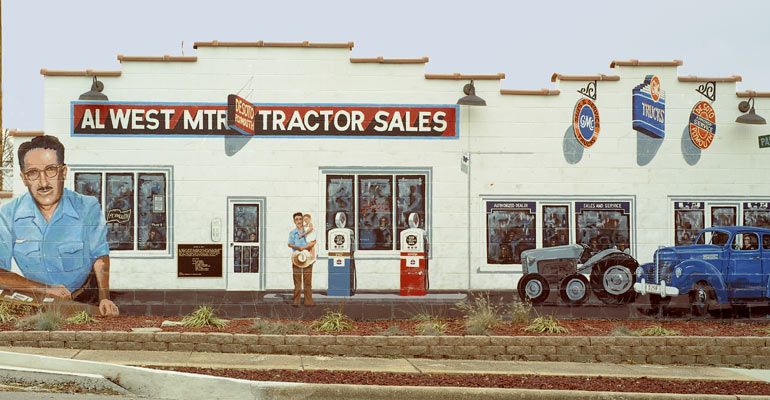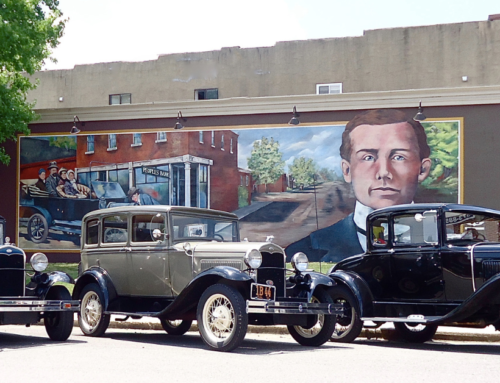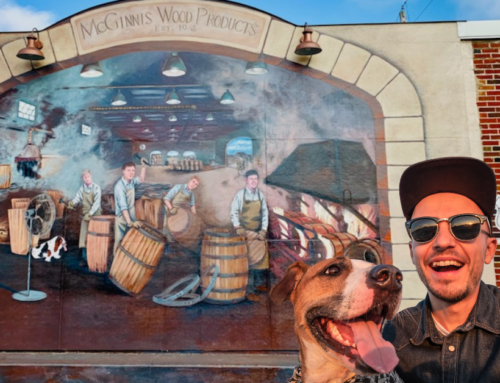
Mayor Al West
201 E Washington Street
Cuba, MO
Al West, Sr. served as Cuba’s mayor from 1946 to 1958. He commemorated in the sixth mural for his civic efforts. At his passing at the age of 81 in 1988, Cuba Free Press editor Percy Pascoe referred to West as the “Father of Modern Cuba.” His vision and aspirations for Cuba formed the base for the modern, economically sound city that Cuba is today.
When West was elected mayor in 1946, he was the first mayor who had been born in Crawford County. Although he had his own business interests to manage, he devoted many personal hours to the city’s interests. At that time, the city had only two paved streets: Hwy. 66 and Hwy.19.
In 1926, the city of Cuba entered into a 20-year franchise agreement with Missouri Electric Power Co. Later, Cicero Ogle, mayor of Cuba in 1945, and his council passed a resolution to purchase the city’s electric system from then owner Show Me Power Coop, Inc. when the franchise expired. When the 20-year lease expired in 1946, Al. West Sr. was then mayor, and it was left to him and his council to complete the purchase with a bonding election, which became hotly contested at some points.
Later, Al West, Sr., then former mayor of Cuba, was presented with a paid-in-full electric revenue bond as a token of the citizen’s of Cuba’s gratitude and esteem for “ the foresight, the wisdom and the fortitude manifested in the planning, bonding and completion of the Municipal Electric System of the City of Cuba.”
It is the light and power system purchased from Sho-Me Power that has provided working capital for the city over the years. Many considered this an extravagant expense at the time. But to West, it was a leap of faith in the future of the city. Consequently, the city went from spending money each month for electricity to using it as a source of revenue to fund the demands of a growing city.
According to West’s personal memoirs that he penned during his retirement, the revenue was used for the following improvements: extension of the sewer and water system to all parts of the city; the building of a new city well; all streets were paved, named, and lit for the first time; house numbering was instituted and street signs were erected; the county fairgrounds were converted into a city park; factories were brought in to provide jobs for the young people; and the grape industry was encouraged and contracts were formed with the Welch Company.
West was reelected for six terms and helped nurture Cuba from a small town with money problems to a town that would hold its own with the growing demands of the 20th century. So as successful towns did all over the United States after World War II, West ushered Cuba into its standing as a modern city. Subsequent mayors were able to strengthen the city and build on Cuba’s success because of West’s early efforts.
It is fitting that West’s mural overlooks the famous Route 66 that was so important to him and to the city that he loved. This time in Cuba’s history reflected the economic post war boom that was occurring in successful small towns nationwide.
After West’s health began to fail, he retired to his country home on the edge of Cuba and built his own studio where he painted his favorite rural scenes. West portrayed famous Americans such as Presidents Richard Nixon and Eisenhower. He began a series of paintings for the Methodist Church depicting the life of Christ, which he had to stop because of health and age. West also painted several wall murals although this wasn’t his favorite style of painting, as it involved considerable amounts of labor. Mr. West passed away in 1988. Because of his work as an artist, West would definitely appreciate the effort involved in creating the current mural.
Lights from the time period were donated to the project and have been mounted on the mural. The West family, some of who are still in the automobile business, commissioned this mural to commemorate Mr. West’s life and work.
Information for this article was gathered from J.I Brewer’s book on Crawford County; David McLain’s article, “Al West, Sr., A Cuba Artist Possesses Skill and Imagination,” Volume X of Backroads magazine; the personal memoirs of Al West, Sr.; editorials by Percy Pascoe, “George Alva West, Sr.–’Father of Modern Cuba’” and “Cuba on the Move”; and in conversations with West’s daughter Rose Bushman.
The Whitesitt Group in St. Louis painted the mural. They are architectural illustrators, model makers, and graphic artists. Artist Jo Ann Kargus, who worked on the project, describes her work as “super-realistic.” According to her, “the more detail the better.”







Leave A Comment